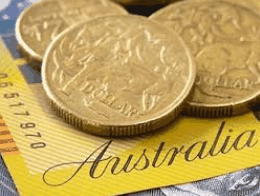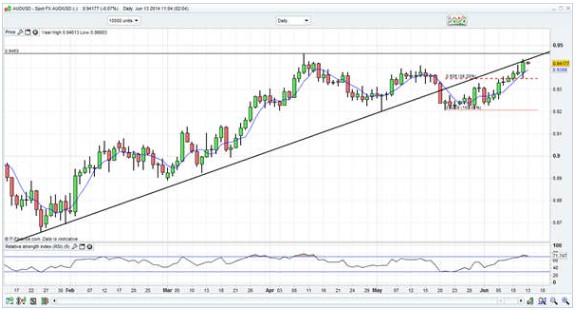
With AUD/USD delicately poised to break the April 10 high of 0.9461, it’s worth having a look at some of the factors influencing this pair at present.
Consensus in the market still suggests that the AUD should settle out the year below 90 cents. US investment bank Morgan Stanley created a stir this week by suggesting it could close the year around the parity mark; a view shared to a slightly lesser degree by the CBA FX research team.
Certainly one of the key rationales behind a potential move to parity expressed by Morgan Stanley is around further inflows into Australian fixed income products.
With Japanese investors still looking to pick up yield where they can, the Australian bond market remains relatively attractive. However, this market has outperformed throughout this fiscal year and from a pure yield perspective it’s unsure if current levels are still attractive. A look at the recent balance of payments data shows the pace of buying from foreigners seems to be subsiding. For example, we have seen a 15% fall in the level of net portfolio inflows into AUD from Q4 13 into Q1 2014, with the fall predominantly driven by a 70% drop in the level foreign buyers of Australian government bonds (ACGBs).
Cross border capital flows are effectively what drive currencies, so we will have to see what happens with future foreign demand to ACGBs. But at present, foreigners hold 67% of outstanding debt, although this percentage has been falling over recent quarters. Still, for anyone trading or investing around AUD/USD, the level of inflows into ACGBs remains one of the key influences for future price action.
The relationship between AUD and commodities
The question of why the AUD has distanced itself from price action in coal, copper, iron ore and gold is still one that comes up time and again. Iron ore plays into Australia’s terms of trade like no other and should have a reasonable influence on the RBA’s policy setting, and of course how the central bank tries to control the price of money.
The key though isn’t to just think of the falls seen in the price of these key exports, but to look at the total value of the exports. The most recent Australian trade data showed that volumes of exports had actually increased 6% in the first few months of the year; thus despite a sharp decline in the price of iron ore, we actually saw the total value increase by 3% – coal was flat. So, while commodity price falls are of course negative, as long as the actual volume of exports keeps the total value stable, the revenue impact is limited and thus the AUD won’t have a strong reaction. Of course if volumes do pull back, then so should the AUD.
Testament to this the 30-day correlation between AUD/USD and iron ore is actually modestly negative for the first time since late 2013. There are also negative correlations with gold and copper.
Positioning likely to drive AUD/USD
Positioning has naturally played a key role as well as. A look at the Commitment of Traders (CoT) report complied each week by the CFTC (to monitor currency futures holdings held by speculative traders) shows a massive turn around, with -65,000 net short contracts held in January. As of early June this figure stood at +21,000. If you go back to 2012, for much of that period these holdings were closer to +75,000 contracts and even over +100,000 contracts; so on this grounds there’s certainly room to move higher.
Naturally the USD plays a key role. However, while the Fed is fairly neutral on the funds rate, there are limited signs of inflation in the US. While the world is keen to pick up high-yielding assets in a time of low volatility, it seems there are better ways to express a positive USD view. Buying the USD against the CHF or EUR seems to be the market’s preferred way to do that.
Technically the very short-term trend is higher, but we are at an interesting juncture. The 20-day moving average (0.9301) is tracking perfectly sideways and the pair is two standard deviations from this average, so we could see mean reversion occur. The former uptrend drawn from the January low on the daily chart is holding up play for now, however it was very positive to see the pair find good buyers after pulling back to the 38.2% retracement of the May to June rally at 0.9350 on Thursday.
With this in mind buying a break of the year’s high of 0.9463 seems logical from a momentum perspective. It could also be good to buy pullbacks on the pair. Potentially buying one parcel at 0.9350 and subsequently another at 0.9301 (the 20-day average), with a potential stop loss at 0.9189 could be how market participants may trade the pair. Short EUR/AUD is still a preferred way of playing a strong AUD.
